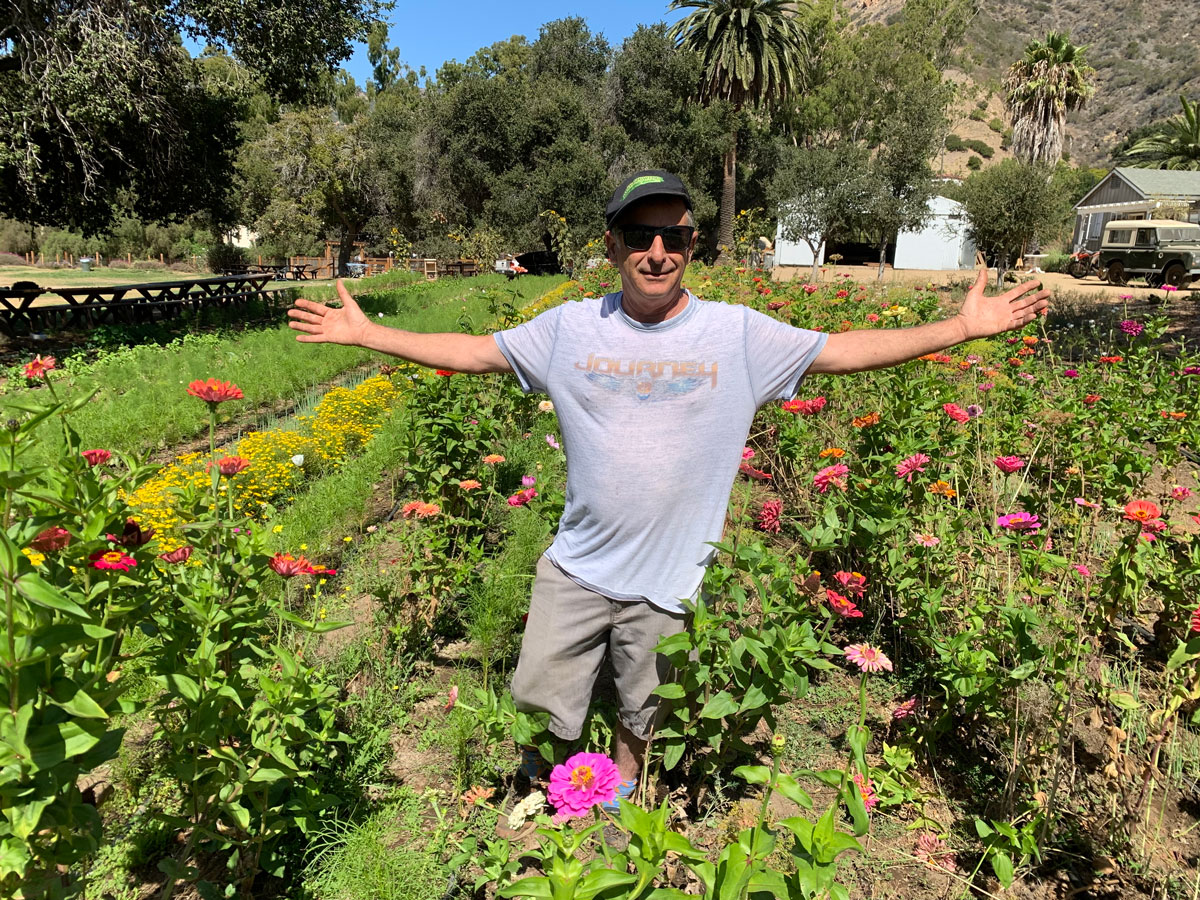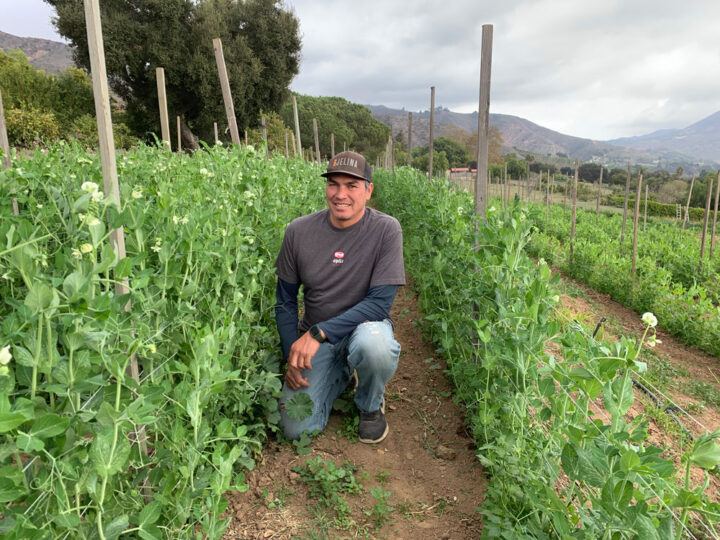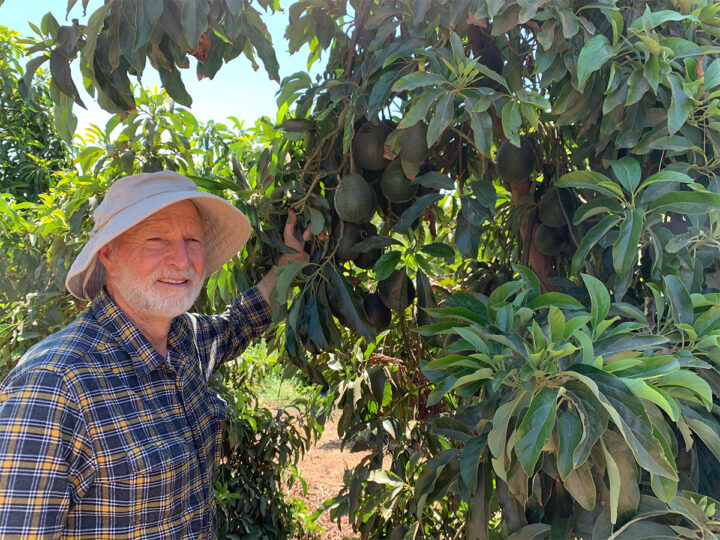If you dine out in Los Angeles, then you’re already well familiar with Weiser potatoes. And carrots. Oh, and melon and sunchokes and radicchio. But those potatoes – chefs have been putting Weiser fingerlings on their menus, by name, for years. And when, some years back, the Weiser family started growing a buttery, otherworldly Alaskan variety called Magic Myrna, it was game over.
A typical reaction was captured in 2019 on Chef Evan Kleiman’s KCRW-FM show, “Good Food,” when Chef Saw Naing, then executive chef at Tallula’s in Santa Monica, was interviewed at the Weiser farmers market stand, saying, “Right now, I am really excited about these Alaskan fingerling potatoes from Weiser. We use a lot of multiple potatoes from him, but this one, particularly, is my favorite.” Explaining it goes into shrimp fajitas, a steak dish, and taquitos, he added, “These potatoes just have the creamy textures – oh my gosh, it’s just really nice.”
As Alex Weiser and I walk his small, new farm in Malibu, he shakes his head, “No potatoes here.” On this plot, part of the original Rindge Ranch, the former 17,000-acre rancho from the late 1800s that became the town of Malibu, he grows flowers, herbs, greens and tomatoes. It’s too small to accommodate the equipment they use to plant and dig potatoes.
“We didn’t start out in potatoes, either,” he adds. “At first it was apples.”

Alex Weiser embracing the zinnias and marigolds at the Malibu farm plot
Alex’s father, Sid Weiser, was a beloved chemistry teacher and counselor at Garfield High School in East Los Angeles, but he had always dreamed of retiring to become a farmer. In 1977, he found a deal in the Los Angeles Times: a 160-acre commercial apple orchard in Tehachapi, with mature and producing trees, that was being sold for the price of the land. Alex’s mom, Raquel, was from Mexico and some of her family partnered with them to buy this farm. Their kids, Dan, Esther, and Alex, were city kids who grew up in the San Gabriel Valley east of LA, and they thought this plan was crazy.
“My dad was a romantic,” says Alex, the youngest, who joined the family farming operation when he was in college in 1982. “He wanted to be a farmer when he was young. My grandparents, his mom and dad, were like, ‘You’re not going to be a farmer.’ Because in Europe, you were poor if you were a farmer. Being a farmer was a bad word for me growing up; even in the ‘80s, when I started farming, I was like, ‘What am I doing?’ I didn’t even call myself a farmer, because it connotated that you’re uneducated and poor.”
They immediately found out how crazy this farm dream actually was. The first year, they got an apple crop and made a little money. Tehachapi is up in the mountains at an elevation of 4300 feet, with enough cold days to make for good fruit. But the orchard was in a low spot on the land and subject to frost, and some years the crop didn’t come in. They lost over a million dollars in the ‘70s.
“It was really scary as hell,” said Alex. “It was just Mother Nature and – that’s farming. But you never heard about small farms doing well. I loved the farming end of it and working with my folks and being in the fresh air. I loved it. The only thing is, you go broke very easily and you lose everything.” He smiles. “That’s the bad part.”
Alex seems to live easily with this kind of contradiction. After farming for 40 years, he still has a wonderful sense of humor about the knife-edge economics of agriculture. One of the best-known farmers in Southern California, he chats constantly at the farmers’ markets, busily refilling and sorting his tables, often holding multiple conversations at once. He clearly belongs there, among friends.
A fellow farmer gave Weisers a start putting rows of potatoes in between their trees. They’re less susceptible to frost, and Tehachapi has a history growing seed potatoes for Idaho farmers. In 1981, when Alex was 17, a guy named Vance Corum, who helped start California’s farmers’ markets program, knocked on their door and told them about markets in Pacoima and Gardena, where they could sell fruit directly to customers without labeling and packaging. Alex started trucking their apples and peaches to the market in Pacoima, and fell in love with farming.
This was a whole new world for farmers. Weisers had been growing for juice companies including Hansen’s, and their only contact was usually a broker, who complained that the fruit wasn’t perfect and tried to knock down the price. They never saw the people who ate their apples. The farmers’ market was different.
“People are happy to see you, and saying how wonderful the food is and getting the love back and appreciation. This feels good,” Alex said. Plus, they started to make some decent money.
First they sold in Pacoima, then Gardena, and then the Santa Monica Farmers’ Market opened, and Weiser has been there ever since.
No one knew that farmers’ markets were going to persist. Farmers were sure that the big grocery chains would pressure the state government to put a stop to them. But Alex’s success at the markets was influential, and the Weisers moved gradually in that direction as they sold the frost-prone commercial orchard and bought a new spot on Highline in Tehachapi where they still are today, sticking with fruit and potatoes. In 1988, Alex got the family into another farm originally growing Fuji apples in Lucerne Valley, way out in the flat of the Mojave Desert on the backside of Big Bear, which he eventually sold. The company became Sid, Raquel and Alex, and then older siblings Dan and Esther joined in, too. Today, they have over 200 acres that rotate in and out of production, some owned and some leased, and now this small spot in Malibu, too.
“People want to move to the country now. Have a couple animals. Being in nature and growing things is so fulfilling. So many people are conscious of what they’re eating.”
Selling in Santa Monica on Wednesday and at the Hollywood Farmers’ Market on Sunday puts them at the epicenter of culinary trends and in touch with the “best palates.” They went organic early on because Sid, as a chemist, knew that was best for food quality and that’s what people wanted. “We were pioneers with Nancy Silverton,” Alex noted, referring to the groundbreaking chef who, with her then-husband, Chef Mark Peel, brought a farm-to-table approach to LA dining with their iconic restaurant, Campanile, and the accompanying La Brea Bakery. She later opened Osteria Mozza and Pizzeria Mozza, and several offshoot restaurants.
Alex recalled that a group of chefs including Silverton, Chef Suzanne Goin (then at Lucques, now A.O.C.) and others organized a meeting with farmers in the 1990s to discuss organic production. They needed more organic and naturally grown produce, and made a kind of pact with the farmers that shaped LA’s dining scene: if they grew it, the chefs would buy it.
So if chefs or home cooks want purple fingerling potatoes or fractal green romanesco, Weiser grows them. Industrial farms, on the contrary, can’t really afford to adapt to such culinary changes until the purple French fry appears at McDonalds. Growing for flavor, and selling to restaurants and farmers’ markets, is the combination that keeps small farms in business.
Grain is not typically one of those farm products produced by small farmers, because of the amount of land involved and the processing and storage required. But about a decade ago, Weiser started growing heritage varieties of wheat, barley and rye that could be dry-farmed – meaning they didn’t need irrigation – in California’s Mediterranean climate. With some help from ancient grains guru Glenn Roberts from Anson Mills, and in partnership with Jon Hammond of Linda Vista Farms and the brilliant Sherry Mandell, they created the Tehachapi Heritage Grain Project to grow grain that was drought-resistant and low-gluten. You’ll often see Sherry at the Santa Monica Farmers’ Market, filling orders behind the scenes for flour, tortillas, and whatever it is she might have baked for someone’s birthday.
This is part of what makes Weiser Family Farms successful: always experimenting. Always in the middle of a revolution. Farming for four decades has shaped Alex’s attitudes about money. He saw how people loved his father, Sid, and how his personality made every day more fun.
“[Other farmers] liked us because we had personality, I think. [Sid] was a kooky guy. We got help. My dad and I would say [farming was about] survival: if we can farm, go to the next year, and then farm the next year, we’re doing great. We have food on our table.”
Sid Weiser, whose picture still appears on all boxes of Weiser produce, passed away in 2020. This was a huge blow to the family, and to the community of cooks and eaters in Los Angeles. But the small-farm way of growing and eating that he helped establish in Southern California is in a resurgence. Alex, as the longtime public face of the company and now the lead farmer, says he sees encouraging signs around him.
“When I started farming, it was not cool,” said Alex. In the 1980s, lots of people wanted to be involved with food as an entrepreneur, but no one wanted to be the farmer.
“But as the years have gone by, I see more and more people interested in farming. I go to universities and speak sometimes. That room is packed. They’re interested. It’s a different mindset. The ‘80 greed, all that, is changing. They don’t want the mega-mansion.
“The younger generations, they’re seeing the value. People want to move to the country now. Have a couple animals. I have friends who are retiring; they want to buy piece of land and grow. Being in nature and growing things is so fulfilling. So many people are conscious of what they’re eating – they weren’t when we started. Now there’s [farmers’] markets everywhere. Getting your daily food, talking to your farmer, talking to your neighbors, knowing where your food comes from. It’s wonderful.”
— Dean Kuipers


